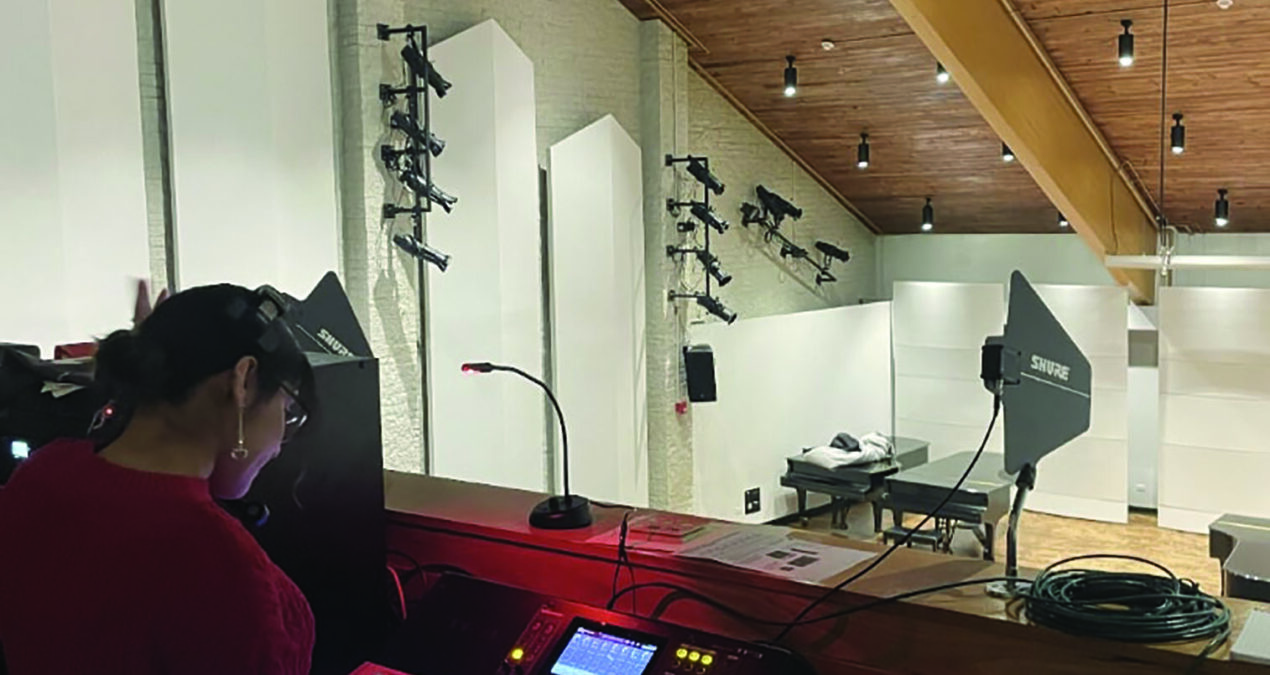Donna Chang, Special to The Denisonian—
The doors of Burke Recital Hall in Michael D. Eisner Center for the Performing Arts creak open as the light in the hallway pierces through the dim, ambient lighting inside the hall. The audience begins to come through the door, overflowing the hall with thunderous chattering, footsteps, and the continuous rustling of clothing.
A soft-pitch voice in the second-level corner of the recital hall gently rings through the headsets of the behind-the-scenes crew members.
“Can you bring the house to half?”
Following the command of the voice, the lights in the hall dim. With a wave of his hand, the conductor set the orchestra sailing into the night with their performance. The owner of the voice who initiated the darkening lights leans against the balcony with her hand against her cheeks, glancing down at the orchestra with admiration.
“I was thinking about what I am going to have for dinner tonight and what homework I have to do,” Linda Contreras Garcia ‘25 said with a laugh. “I also thought that they were so talented. When it’s the orchestra, I am heart-eyed.”
Contreras Garcia ‘25 is majoring in communication and minoring in earth and environmental science.During the day, she carries her North-Face backpack, wears her thin, black, round-framed glasses, and holds an iced latte in the hallways between Higley and Olin. At night, she works as the performance technician in the crew and sometimes as the stage manager, light and audio technician, and mainly, as the Singer Theatre sound engineer. Also known as the “sound girl.” Contreras Garcia’s work hours are dependent on the event featured. Her rigorous work ranges from two to five hour shifts and occasionally, two nights in a row. The crew works in a fast-paced environment that requires full attention.
“It’s like we are little ants in the colony,” said stage manager Ikera Olandesca ‘26.
Contreras has worked in the hall since her freshman year.
“When people see live performances, it’s easy for attention to stay on stage with the actors and actresses,” Contreras Garcia said. “The off-stage is often unseen.”
Although the behind-the-scenes crew is sometimes overlooked, Contreras Garcia loves seeing art come to life and bringing the script onto the stage.
“Imagine a show without lighting, sound, music or set. Can you call that a show?” she said.
She was once a cinema major, but Contreras Garcia didn’t get what she wanted: hands-on experience and a set of tools and knowledge.
“I always have that interest in how things came to be,” she said.
Contreras Garcia has also always been fascinated with outer space, the water cycle, and the carbon cycle. Her double major allows her to explore these further. The combination of these two fields made sense to Contreras Garcia’s academic pursuits. However, it did not make sense to others.
“I see the conflict in their eyes,” Contreras Garcia said. “It sucks when people’s reactions only light up when I mention earth and environmental science.”
When faced with the question, “What do you want to be when you grow up?” Contreras Garcia’s relatives would answer on her behalf: doctor, engineer, or lawyer. As a first-generation college student, Contreras Garcia’s parents ingrained the importance of an education.
“They couldn’t continue studying because they decided to support their family,” Contreras Garcia said. “And education is expensive in their country so they stopped in middle school.”
Her family, friends, and teachers uphold a belief that good-paying jobs are in law, medicine, and technology, though she disagrees.
“I am a firm believer that the fields of humanities and STEM are equally important,” she said.
Besides working in the performing arts, Contreras Garcia also works as a lab research assistant in the earth and environmental science department.
“Sometimes there would be a day where I finish my shift at a research lab and I have a 30-minute break,” she said. “And I would head down to Eisner to work on the performance show.”
Elizabeth Dauterman, production manager at Eisner and Contreras Garcia’s supervisor, recognizes her effort.
“She has this running Google Doc, all the learning goes in there. I know she is with me,” Dauterman said. “It’s a big job. With 30 people standing in front of you waiting for you to say something.”
Working in performance art allows Contreras Garcia to get “a bit of chaos” and keep up with her creative side. The repetitiveness of the lab work calms her mind down.
“Both the research lab and the performance space require one to dedicate time and effort,” she said. “It reinforces the idea that one set of knowledge is not above the other. My favorite thing to do is to merge the two. One can’t exist without the other. Technology, microphone, soundboard, and audio bring art to life.”

